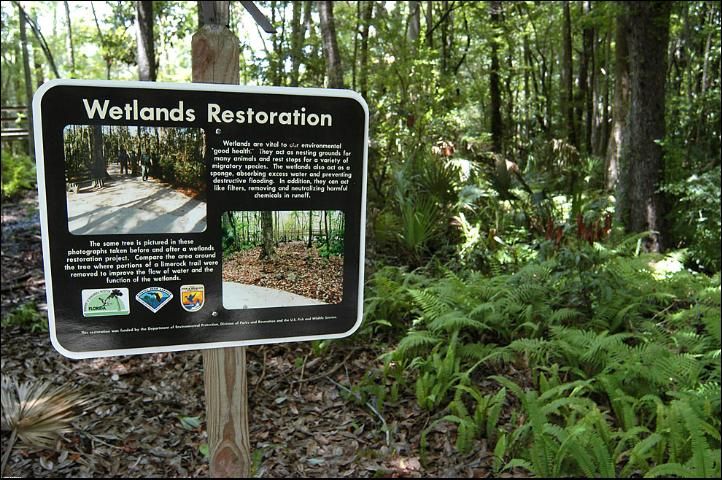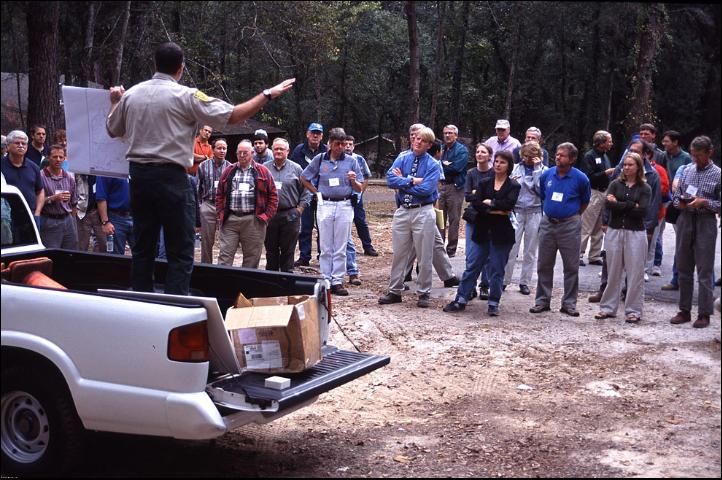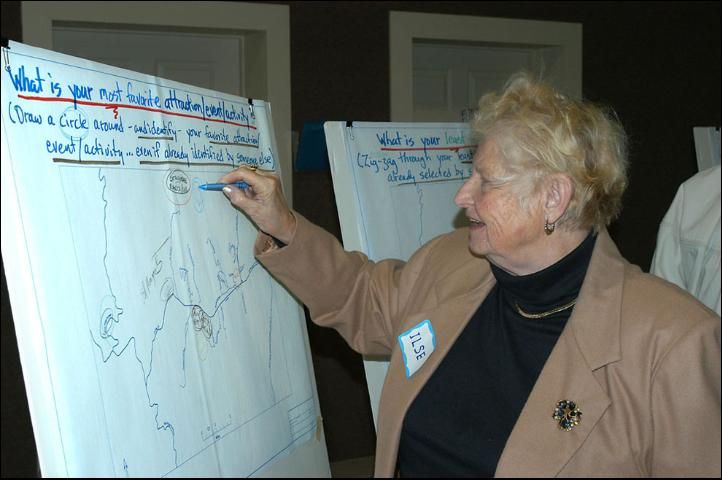Starting an Informal Presentation in the Wildland-Urban Interface
Extension agents and natural resource professionals typically conduct programs and lead presentations to convey important information to interested audiences. For many of us, the information is the easy part. We know a lot and have a good idea of what we need to say. The trick, however, is figuring out how to say it. Many of the words that experts are comfortable using do not communicate well to our audiences. Another aspect of how to deliver a message is the challenge of just getting started. Experts have a tendency to jump right in to the content, leaving audience members floundering in the wake. A more effective introduction connects to what the audience knows and cares about so they are more committed to following your entire message.
This fact sheet highlights two important elements of starting successful presentations 1) avoiding words and phrases that do not communicate as you intend; and 2) launching a presentation in such a way that audiences feel you are speaking to them.
Choose the Right Words
The words we choose to convey ideas may have different meanings to different people. The technical language that natural resource agents and professionals use with ease may not be understood by the public. To help translate environmental messages into appropriate and everyday vocabulary, The Nature Conservancy and the Trust for Public Land contracted with two public opinion research firms in 2004 (Weigel, Fairbank, and Metz 2005). Their results are reported below and suggest some ideas that wildland-urban interface communicators could find helpful.
One of the most important resources to people is water. Water should be talked about first and foremost. Water is a critical reason to protect land for the purpose of protecting drinking water and improving water quality in surface water. Since most people do not consider water a problem right now, we should stress the importance of investing in preserving water quality for the future (see Figure 1).
Protecting wildlife is a popular concept with people because there is a sense that animals are voiceless and need people to protect them. "Wildlife habitat" resonates more with people who are active in environmental causes than with people who are not aware of or do not share those interests. "Wildlife protection" garners broad support, while the term "endangered species" tends to polarize people.
Land conservation is important to communicate yet tricky to explain clearly. There are a number of phrases that do not work well. People think of "open space" as empty, far away lands that are not beneficial to them. Many focus groups' respondents thought that "easements" force people to do or not do something with part of their land. The phrase "buying development rights" was often interpreted as buying land in order to develop it. The term "sprawl" elicited very negative reactions. People thought the term "undeveloped land" refers to land that will be developed in the future. People did not have any idea what the term "working landscapes" means.
In speaking about land conservation, the following phrases are likely to communicate better than those mentioned above. Instead of "open space," use the phrase "natural areas," which evoked images of trees, mountains, streams, or waterfalls. Use the terms "land preservation agreements" or "conservation agreements" instead of "conservation easements." Use the phrase "poorly planned growth," as opposed to "unplanned growth" or "sprawl." Linking land conservation to protecting "working forests, farms and ranches" resonates as a very important reason for land to be preserved. The words forest, farm, or ranch must follow "working"; this gives people a sense that the land is productive and how it is being used to benefit owners and others.

Credit: Larry Korhnak
Getting Started
The first section of a presentation must convey a number of things simultaneously. You need to appear friendly, interesting, and trustworthy. A stilted "I came here today to talk to you about your water quality" does not convey the informal friendliness that you would like to establish and might create a perception that you think you know more than they do. In addition, your topic must be introduced so that people believe it is relevant and worth knowing about. Clearly, the more you know about your audience the better you will be able to predict how to approach them.
Many communicators conduct audience assessments to obtain this background information. They typically seek information about what the audience knows, what they want to know, what they care about, and what they are confused about. Focus groups, surveys, and informal conversations are good strategies for collecting this information. If an audience assessment has not been conducted, you can still use your introduction to collect information and build a relationship with your audience. You can ask a number of questions and you can discover how the audience is different from your preconceived notions of who will attend. These questions can help you put audience members in a receptive state of mind and gain their trust by encouraging their participation.
Who are they? The information you have gathered about your community or the work you have done in this area has given you a general background about what people tend to know and believe, but you do not know how well this particular audience matches your assessment. You can begin your presentation by asking assessment-type questions to gauge their interest and knowledge (see Figure 2).

Credit: Larry Korhnak
This will help you compare the information you gleaned from your audience assessment to the group sitting in front of you:
- Who lived here during the last major drought?
- How many of you commute to Naples every day?
- How many of you are retired?
You could present the information from your assessment or from initial conversations and ask this audience if it rings true:
In talking with a variety of people, I've come to some conclusions that I'd like to check with you. It seems that there are a lot of commuters in the community who simply don't have time to work on their landscapes. Does this sound fairly accurate to you?
What do they care about? Asking questions about opinions and beliefs may give you insight into the audience's attitudes; are they skeptical or willing to change their ideas? How strongly do they hold these opinions? You might start with basic questions about the topic and move to practices:
- What do you know about the water quality in this area?
- Where did you hear that?
- How many of you buy bottled water?
- Which is more important to you right now—the quality of water in your tap or the river?
- Which might be more important to future residents 50 years from now?
Where does their information come from? Asking people how they know what they think is true is a very interesting line of questioning (see Figure 3).

Credit: Larry Korhnak
Did they hear it from a neighbor, read it in a newspaper, or see it with their own eyes? Starting a conversation about how people know something might give you a clue about the misconceptions people have, how strongly they hold certain ideas, and what evidence they have to support those ideas. It helps if you know where they got their information:
- What do you read in the newspaper about invasive species in this area?
- Did anyone see the TV special recently on aliens in the backyard?
- Have you heard about this topic from presentations to local business and professional clubs (Rotary, Lions, etc.)?
- Did anyone read the utility bill insert about water quality?
- Do your neighbors talk about the trouble they have with nuisance wildlife?
- Did anyone pick up a flyer on firewise landscaping at the community festivals?
Summary
The beginning of a presentation is a critical time. You will not get a second chance to start over! It is important to understand how key phrases are perceived by audiences and to use the most appropriate words to communicate effectively. Connecting conservation proposals with "future generations" is an effective approach with most audiences—whether they are parents or not.
It is also important to convey an engaging and friendly attitude to your audience to help them trust you and want to learn from you. A discussion with them at the beginning of a presentation need only take a few minutes. It is meant to begin to build a bridge between the audience and your office or agency. It necessitates good listening skills, which will help your audience feel respected. It enables you to gather background information to help you make the presentation more relevant and meaningful for the group. And it gives you a way to start!
Successful presentations often equalize the relationship with homeowners. If you set yourself up as an expert, some people will respond with resistance (You're not telling me what to do) or helplessness (I just can't know enough to do it right; you'll have to do it for me). Aim for an equal partnership in which each person brings different skills that are critical to success. You bring technical expertise. The audience brings motivation and the capability to act in their own best interests to accomplish the task at hand.
Reference
Weigel, L., J. Fairbank, and D. Metz. 2005. Memorandum to The Nature Conservancy and Trust for Public Land.


